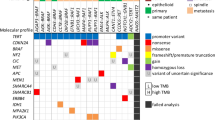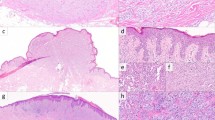Abstract
Oncogenic BRAF fusions have emerged as an alternate mechanism for BRAF activation in melanomas and other cancers. A number of BRAF fusions with different 5′ gene partners and BRAF exon breakpoints have been described, but the effects of different partners and breakpoints on cancer phenotypes and treatment responses has not been well characterized. Targeted RNA sequencing was used to screen 60 melanoma patient-derived xenograft (PDX) models for BRAF fusions. We identified three unique BRAF fusions, including a novel SEPT3-BRAF fusion, occurring in four tumors (4/60, 6.7%), all of which were “pan-negative” (lacking other common mutations) (4/18, 22.2%). The BRAF fusion PDX models showed variable growth rates and responses to MAPK inhibitors in vivo. Overexpression of BRAF fusions identified in our study, as well as other BRAF fusions previously identified in melanomas, resulted in a high degree of variability in 2D proliferation and 3D invasion between the different fusions. While exogenously expressed BRAF fusions all responded to MAPK inhibition in vitro, we observed potential differences in signaling and feedback mechanisms. In summary, BRAF fusions are actionable therapeutic targets, however there are significant differences in phenotypes, treatment responses, and signaling which may be clinically relevant.
This is a preview of subscription content, access via your institution
Access options
Subscribe to this journal
Receive 50 print issues and online access
$259.00 per year
only $5.18 per issue
Buy this article
- Purchase on Springer Link
- Instant access to full article PDF
Prices may be subject to local taxes which are calculated during checkout




Similar content being viewed by others
References
Baiter M, Schuler G, Hartmann A, Schneider-Stock R, Heinzerling L. Pathogenetic implications of BRAF mutation distribution in stage IV melanoma patients. Dermatology. 2015;231:127–33.
Gautschi O, et al. Targeted therapy for patients with BRAF-mutant lung cancer: results from the European EURAF Cohort. J Thorac Oncol. 2015;10:1451–7.
Klempner SJ, et al. BRAFV600E mutations in high-grade colorectal neuroendocrine tumors may predict responsiveness to BRAF-MEK combination therapy. Cancer Discov. 2016;6:594–600.
Linnekamp JF, Wang X, Medema JP, Vermeulen L. Colorectal cancer heterogeneity and targeted therapy: a case for molecular disease subtypes. Cancer Res. 2015;75:245–9.
Alatrash G, Jakher H, Stafford PD, Mittendorf EA. Cancer immunotherapies, their safety and toxicity. Expert Opin Drug Saf. 2013;12:631–45.
Mar VJ, et al. The role of BRAF mutations in primary melanoma growth rate and survival. Br J Dermatol. 2015;173:76–82.
Baitei EY, et al. Aberrant BRAF splicing as an alternative mechanism for oncogenic B-Raf activation in thyroid carcinoma. J Pathol. 2009;217:707–15.
Poulikakos PI, et al. RAF inhibitor resistance is mediated by dimerization of aberrantly spliced BRAF(V600E). Nature. 2011;480:387–90.
Villanueva J, et al. Concurrent MEK2 mutation and BRAF amplification confer resistance to BRAF and MEK inhibitors in melanoma. Cell Rep. 2013;4:1090–9.
Botton T, et al. Recurrent BRAF kinase fusions in melanocytic tumors offer an opportunity for targeted therapy. Pigment Cell Melanoma Res. 2013;26:845–51.
Hutchinson KE, et al. BRAF fusions define a distinct molecular subset of melanomas with potential sensitivity to MEK inhibition. Clin Cancer Res. 2013;19:6696–702.
Jain P, et al. Overcoming resistance to single-agent therapy for oncogenic BRAF gene fusions via combinatorial targeting of MAPK and PI3K/mTOR signaling pathways. Oncotarget. 2017;8:84697–713.
Kim HS, et al. Oncogenic BRAF fusions in mucosal melanomas activate the MAPK pathway and are sensitive to MEK/PI3K inhibition or MEK/CDK4/6 inhibition. Oncogene. 2017;36:3334–45.
Lu H, et al. Engineering and functional characterization of fusion genes identifies novel oncogenic drivers of cancer. Cancer Res. 2017;77:3502–12.
Menzies AM, et al. Clinical activity of the MEK inhibitor trametinib in metastatic melanoma containing BRAF kinase fusion. Pigment Cell Melanoma Res. 2015;28:607–10.
Turner J, et al. Kinase gene fusions in defined subsets of melanoma. Pigment Cell Melanoma Res. 2017;30:53–62.
Ross JS, et al. The distribution of BRAF gene fusions in solid tumors and response to targeted therapy. Int J Cancer. 2016;138:881–90.
Couts KL, et al. ALK inhibitor response in melanomas expressing EML4-ALK fusions and alternate ALK isoforms. Mol Cancer Ther. 2018;17:222–31.
Lavoie H, et al. MEK drives BRAF activation through allosteric control of KSR proteins. Nature. 2018;554:549–53.
Takeuchi K, et al. RET, ROS1 and ALK fusions in lung cancer. Nat Med. 2012;18:378–81.
Wang L, et al. Identification of NTRK3 fusions in childhood melanocytic neoplasms. J Mol Diagn. 2017;19:387–96.
Sievert AJ, et al. Paradoxical activation and RAF inhibitor resistance of BRAF protein kinase fusions characterizing pediatric astrocytomas. Proc Natl Acad Sci USA. 2013;110:5957–62.
Brummer T, et al. Functional analysis of the regulatory requirements of B-Raf and the B-Raf(V600E) oncoprotein. Oncogene. 2006;25:6262–76.
Germann UA, et al. Targeting the MAPK signaling pathway in cancer: promising preclinical activity with the novel selective ERK1/2 Inhibitor BVD-523 (Ulixertinib). Mol Cancer Ther. 2017;16:2351–63.
Fouad YA, Aanei C. Revisiting the hallmarks of cancer. Am J Cancer Res. 2017;7:1016–36.
Feitelson MA, et al. Sustained proliferation in cancer: Mechanisms and novel therapeutic targets. Semin Cancer Biol. 2015;35(Suppl):S25–S54.
Jiang WG, et al. Tissue invasion and metastasis: Molecular, biological and clinical perspectives. Semin Cancer Biol. 2015;35(Suppl):S244–75.
McGranahan N, et al. Clonal status of actionable driver events and the timing of mutational processes in cancer evolution. Sci Transl Med. 2015;7:283ra254.
Hennig A, et al. Feedback activation of neurofibromin terminates growth factor-induced Ras activation. Cell Commun Signal. 2016;14:5.
Ueki K, et al. Feedback regulation of mitogen-activated protein kinase kinase kinase activity of c-Raf-1 by insulin and phorbol ester stimulation. J Biol Chem. 1994;269:15756–61.
Alessi DR, Cuenda A, Cohen P, Dudley DT, Saltiel AR. PD 098059 is a specific inhibitor of the activation of mitogen-activated protein kinase kinase in vitro and in vivo. J Biol Chem. 1995;270:27489–94.
Weiss RH, Maga EA, Ramirez A. MEK inhibition augments Raf activity, but has variable effects on mitogenesis, in vascular smooth muscle cells. Am J Physiol. 1998;274:C1521–9.
Li E, Wimley WC, Hristova K. Transmembrane helix dimerization: beyond the search for sequence motifs. Biochim Biophys Acta. 2012;1818:183–93.
Ortore MG, et al. Structural and thermodynamic properties of septin 3 investigated by small-angle X-ray scattering. Biophys J. 2015;108:2896–902.
Fischer A, et al. Regulation of RAF activity by 14-3-3 proteins: RAF kinases associate functionally with both homo- and heterodimeric forms of 14-3-3 proteins. J Biol Chem. 2009;284:3183–94.
Bagby S, et al. Development and maintenance of a preclinical patient derived tumor xenograft model for the investigation of novel anti-cancer therapies. J Vis Exp. 2016;115:54393.
Tentler JJ, et al. Patient-derived tumour xenografts as models for oncology drug development. Nat Rev Clin Oncol. 2012;9:338–50.
Scolnick JA, Dimon M, Wang IC, Huelga SC, Amorese DA. An efficient method for identifying gene fusions by targeted RNA sequencing from fresh frozen and FFPE samples. PLoS ONE. 2015;10:e0128916
Schneider CA, Rasband WS, Eliceiri KW. NIH Image to ImageJ: 25 years of image analysis. Nat Methods. 2012;9:671–5.
Couts KL, Anderson EM, Gross MM, Sullivan K, Ahn NG. Oncogenic B-Raf signaling in melanoma cells controls a network of microRNAs with combinatorial functions. Oncogene. 2013;32:1959–70.
Acknowledgements
We thank the patients and their families for donating tissue to the International Melanoma Biorepository and Research Laboratory at the University of Colorado Cancer Center. We thank the Melanoma Scientific Advisory Board at the University of Colorado for their support. The work presented here was supported in part by the Amy Davis Foundation, the Moore Family Foundation, and the Heidi Horner Foundation. Additionally, funding was also provided by the Genomic and Microarray Shared Resource of Colorado’s NIH/NCI Cancer Center Support Grant P30CA046934, NIH/N CATS CCTSI Grant UL1 TR001082, and Cancer League of Colorado.
Author information
Authors and Affiliations
Corresponding author
Ethics declarations
Conflict of interest
The authors declare that they have no conflict of interest.
Electronic supplementary material
Rights and permissions
About this article
Cite this article
Turner, J.A., Bemis, J.G.T., Bagby, S.M. et al. BRAF fusions identified in melanomas have variable treatment responses and phenotypes. Oncogene 38, 1296–1308 (2019). https://doi.org/10.1038/s41388-018-0514-7
Received:
Revised:
Accepted:
Published:
Issue Date:
DOI: https://doi.org/10.1038/s41388-018-0514-7
This article is cited by
-
The role of CRAF in cancer progression: from molecular mechanisms to precision therapies
Nature Reviews Cancer (2024)
-
Establishment and characterization of patient-derived xenograft of a rare pediatric anaplastic pleomorphic xanthoastrocytoma (PXA) bearing a CDC42SE2-BRAF fusion
Scientific Reports (2023)
-
Kinase gene fusions: roles and therapeutic value in progressive and refractory papillary thyroid cancer
Journal of Cancer Research and Clinical Oncology (2021)



